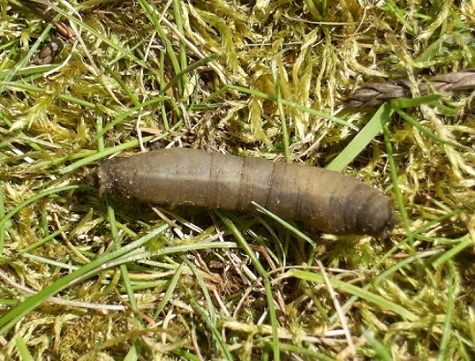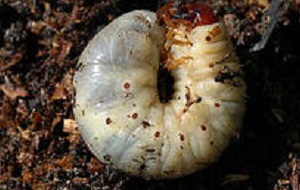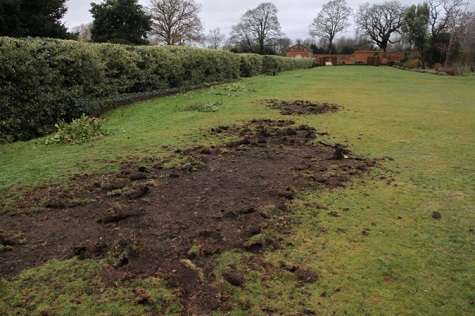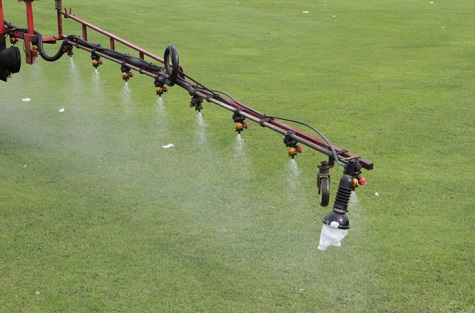Turfgrass pests are becoming a very urgent problem for many turfgrass managers in the UK.
The withdrawal of chemical pesticides has left many with no apparent answer to the devastation caused by insect larvae of the Crane Fly (Leather Jackets) and Chafer Beetle (Chafer Grubs).
There is, however, hope as effort is put into finding legal alternatives to chemical pesticides.

Control of pests falls within three types:
- Chemical
- Biological
- Physical
Chemical controls
With rapid advances in the physical, chemical, and biological sciences since the late 19th century, pest control became focussed on using cost effective and quick acting synthetic based chemicals. The recognition that these formulations have harmful effects on human health and can cause widespread environmental damage has led to their gradual withdrawal. The turfgrass industry is now faced with only Emergency Authorisation for some formulations to control insect larvae, e.g. Acelepryn in 2019, and which can only be applied once per year.
Biological controls
Biological controls, e.g. using proprietary nematodes and genetically engineered bacteria, can help but the cost is prohibitive for many golf and sports clubs. Specific conditions have to be met before application of some of these methods, e.g. temperature and moisture, making success a lottery. Low cost compost teas and biostimulants can be extremely effective when used over a period of time and are an area of expertise of mine. The key is understanding which biostimulant is required for specific purposes, i.e. pest control, rooting and heat/cold tolerance.

Yet, even with regular use of biological controls and biostimulants, there comes a time when a pest or fungal pathogen needs to be controlled, i.e. sometimes you just need to kill something! Protecting your employer’s asset, and your job security, takes priority over how pests are controlled and this situation creates a demand for alternative control methods, such as physical controls.

Physical controls
Greenkeepers and Groundsmen are familiar with chemical pesticides and many are using biological methods, but not so many are aware of the available physical controls. Due to the tremendous success of chemicals physical control methods have been set aside, and some people may view the use of physical control methods as a step backward to some distant, pre-industrial age. However, recent advances have resulted in an increase in research and application of physical controls. Physical control methods are grouped under two main classes, passive and active;
1. Passive controls include:
• Physical barriers, defined as any living or non-living material used to restrict movements or to delineate a space, such as trenches and fences to stop crawling and flying insects
• Organic and artificial material mulches
• Particle films, e.g. kaolin, which disrupt insect feeding habits
• Inert dusts, e.g. lime, common salt, sand, kaolin, paddy husk ash, wood ash, clays, diatomaceous earths, synthetic and precipitated silicates and silica aerogels
• Trapping
• Oils, which act primarily at contact sites by obstruction of the respiratory system (hypoxia)
• Surfactants and soaps, which have an interaction with water on insect and larvae cuticles and causing drowning by helping water to infiltrate tracheae
2. Active physical controls
Active methods are used to destroy, injure, or induce stress in crop pests or to remove them from the environment, and can be classified according to the mode of energy use and include:
• thermal shock (heat or cold)
• electromagnetic radiation (microwaves, UV & visible light and radio frequencies)
• mechanical shock,
• pneumatic control (blowing or vacuuming tools).
Are physical controls regulated?
The regulatory framework for physical control differs markedly from that for agrochemical products. Many physical techniques are subject to rules concerning how they are applied, rather than how they control pests, and are designed to protect users and the general public. For example, the use of propane gas requires specialized training, as does the use of spraying equipment.

In the UK, chemical pesticides fall under the Plant Protection Products (Sustainable Use) Regulations 2012 (PPPR). On enquiring about products that work by physical action I received the following statement from the HSE:
Where a product has been determined by a scope exercise to act by physical means, then it is no longer considered to be in scope of PPPR and HSE have no jurisdiction over those products; however what we are able to action on is to ensure that such products are not making claims that fall under the scope of PPPR, even if they are considered to be a low health risk.
In summary, physical controls are not classed as pesticides and do not come under the PPPR, unless pests are controlled by actions similar to a chemical pesticide, e.g. poisoning.
Chemical and biological methods are sometimes incompatible but biological, cultural, and physical methods can be compatible. Industry demand, and economic and legislative incentives, will necessitate the use of physical control methods as alternatives to chemical pesticides.
Example of a physical control product
TurfSolv is a blend of food grade vegetable oil and surfactants and is totally safe for human health and welfare. The product works by the oil/surfactant coating and penetrating into every orifice of the pest and it dies from asphyxiation, which is a classed as physical control. In other words, TurfSolv:
• controls pests of turf
• is fully legal to use
• is totally safe to use
The application rate is 10L of TurfSolv in 1000L of water per hectare. It is a lot of water but the 1:100 dilution is critical in how the product works. If too much product is used it will not be diluted sufficiently to get into every pore of the pest and stop it from respiring. It will be easier for most users to dilute 5L in 500L water and apply to 5000m2, and then do it again for the full hectare.
For severe infestations apply once, and then again 7 days later. Assess the control and apply again 7 days after the second dose if necessary. Otherwise, apply every 3-4 weeks to keep control. The grubs take a few days to die and the second/third sprays will ensure that larvae are caught at different growth stages.
More information can be found at www.turfsolv.com - it is very American but we will be manufacturing in the UK this year and are developing UK websites and info.
This gives the turfgrass industry hope that effective insect pest control is still possible. TurfSolv is currently supplied from the USA but will shortly be manufactured in the UK.
For information on pricing contact Andrew Turnbull on 07900 692052, or andrew@grassexpert.co.uk.